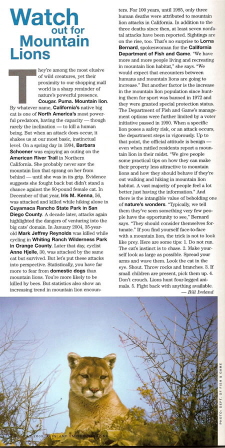FEATURE ARTICLES
California's Big Cats
Published in Inland Empire Magazine
("Watch Out For Mountain Lions")
They’re the most elusive of wild creatures. That, along with their legendary fierceness, provides plenty of fuel for imagination. Their proximity to our civilized, shopping mall world is a rude reminder of nature’s power — and mystery.
Cougar. Puma. Mountain lion. By whatever name, California’s native big cat inspires awe, intrigue and fear.

Few animals have the capacity and disposition to kill a human being. Mountain lions do. On a spring day in 1994, Barbara Schoener was enjoying an outing on the American River Trail in northern California. She probably never saw the mountain lion that sprang on her from behind — till she was in its grip. Evidence suggests she fought back bravely, but didn’t stand a chance against the 80-pound cat.
More recent events in southern California are even more disturbing: in January 2004, two cyclists were attacked the same day in Whiting Ranch Wilderness Park, one fatally. In December 1994, a hiker was attacked and killed in Cuyamaca Rancho State Park.
These incidents can easily be dismissed as flukes. Statistically, you have far more to fear from domestic dogs than mountain lions. Indeed, you’re more likely to be struck by lightning, or killed by bees. But statistics also show an inexorable increase in mountain lion encounters, as humans encroach on their turf.
For a hundred years, till 1985, only three human deaths were attributed to mountain lion attacks in California. That number was matched in the next 20 years, from 1985 to the present. The same period saw at least seven non-fatal attacks. Sightings have increased just as dramatically.
It’s no surprise to Lorna Bernard, spokesperson for the California Department of Fish and Game. “We have more and more people living and recreating in mountain lion habitat,” she says. “We would expect that encounters between humans and mountain lions are going to increase.”
It’s a consequence of unprecedented land development, but also of lifestyle. New residents aren’t just filling in the canyons and hillsides; they’re also exploring the wild places in greater numbers. It’s no coincidence that the most recent victims were mountain bikers. That trendy sport has radically extended the range of wilderness that humans can traverse in a given day.
But another issue lurks behind these events. The increased encounters coincide with the end of recreational mountain lion hunting in 1972, and the subsequent granting of special protection status. Sportsmen and alarmed citizens point to that as evidence of a flawed policy. Wilderness advocates blame humans for intruding into mountain lions’ territory.
Caught in the middle is the Department of Fish and Game, whose management options were further limited by a voter initiative passed in 1990. Bernard is diplomatic about the department’s dilemma: “The people have spoken, and the laws that we have on the books now are what we work with.”
So, is the mountain lion population increasing, or not? “We feel the mountain lion population is stable,” Bernard says. “A few years ago, we said stable to increasing. We certainly don’t see them declining.”
When a particular lion poses a safety risk, or an attack occurs, the department steps in vigorously. Up to that point, the official attitude is benign — even when rattled residents report a mountain lion in their midst. “We get hundreds of reports every year,” says Bernard. The department’s role becomes one of informing, and comforting. “People call us because they’re afraid, and they want to know: Does this mean there’s a threat? We give people some practical tips on how they can make their property less attractive to mountain lions, and how they should behave if they’re out walking and hiking in mountain lion habitat. A vast majority of people feel a lot better just having the information.”
And, there is the intangible value of beholding one of nature’s wonders. “Typically, we tell them they’ve seen something very few people have the opportunity to see,” Bernard says. “They should consider themselves fortunate.”
Visit the California Department of Fish and Game at www.dfg.ca.gov.
# # #